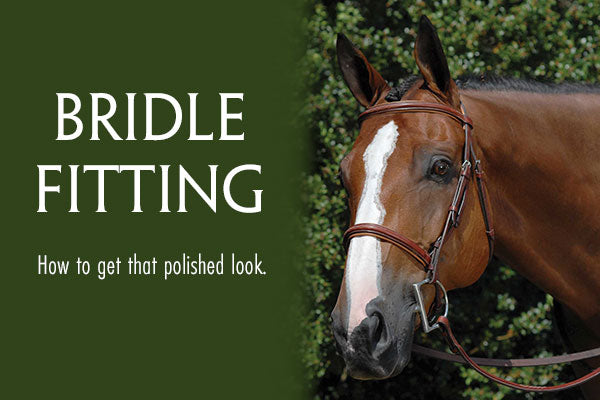When we see a horse and rider enter the arena looking polished and put-together, we see it as beautiful, and may even comment on how gorgeous they look. But how do you get the polished look? What are the secrets of looking so professional and well-groomed?
Properly fitting your tack is a fundamental requirement for that polished look. Follow these basic rules for fitting your bridle and you, too, can accomplish a top-notch, winning look.
BROW BAND
Brow bands that are properly fitted will place the crown piece comfortably behind the base of the ears. If it’s too small, it will cause the crownpiece to rub your horse behind the ears. If it’s too big, the brow band will gap in the center of your horse’s forehead, or hang down over your horse’s eyes. Most brow bands are interchangeable, so be sure to use the proper width for your horse's brow.
CHEECKPIECES
Cheekpieces are a crucial part of the bridle. They are functional, yet when properly fit, they create a finished look. In terms of functionality, the cheekpieces place the bit in the proper position. When adjusted correctly, there will be a wrinkle or two in the corners of your horses’ mouth.
Buckles that are properly adjusted are critical to creating a polished look and balancing your horse's face. When the cheekpieces are adjusted correctly, the buckles should lie next to, or within one-half inch above, your horse’s eye. If they are in any other position, they are the wrong size for your horse. Longer cheekpieces can be made shorter if necessary.
THROATLATCH
The throatlatch has just one function: to prevent the bridle from coming off your horse’s head. When properly adjusted, the throatlatch allows the throat to expand when the head is flexed. If it’s too loose it will not perform its intended function. You should be able to fit your closed fist between the leather and your horse’s throat.
NOSEBAND
The noseband should be placed two fingers width below your horse's cheekbones. The cheek leather should rest about a half inch behind the cheekbone. A standard/non-crank noseband should encircle your horse’s nose and allow you to slip two fingers between the jaw and the leather. For a crank noseband, tighten it completely without making the horse uncomfortable.
Vespucci bridles feature padding in all the places where pressure is likely to be felt on the horse's face. Over the crown, under the jaw, on top of the nose. Vepucci bridles, designed by Peter Menet of Amerigo Saddles, were the first bridle to introduce the concept of the single crown. This means the cheekpieces and noseband are all integrated into one piece as they pass over your horse's head, behind the ears. When combined with padding, this ensures that the sensitive area behind your horse's ears is well protected.
Padding is also integrated on the noseband under the jaw. It's specifically designed to allow tightening of the noseband, while maintaining the proper position of the padding to protect the bars of your horse's jaw.
And finally, Vespucci bridles feature padding over the nose. Padded leather is used since other materials such as sheepskin will breakdown and become dirty over time. The padded leather is easy to clean, gets softer with each use, and creates a beautiful, classic look on your horse's face.
Keep in mind, each riding discipline has their own style of tack and dress. Get up-to-date on equipment requirements for your discipline by doing some research within the rulebook of USEF (visit www.usef.org).
And to see the full range of our bridle options and get additional bridle tips, visit our Vespucci Collection.

